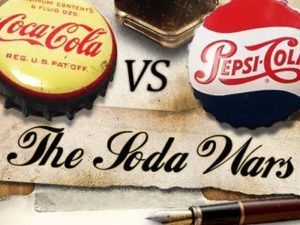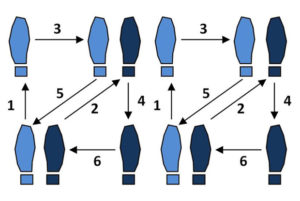9 minutes to read
 “We’re all the same”
“We’re all the same”
The other day I was discussing how the competitors in a particular industry differentiated themselves from one another.
One of the participants nodded knowingly and said “We’re all saying the same things, we’ve got basically the same feature set. No one is different from anyone else. We’re all chasing the same thing.”
Really?
In many mature markets, whether its soft drinks like coca-cola or lemonade through to televisions, or even sophisticated products like electronic cameras, smartphones, IT systems or airport baggage conveyor belts, you could say that each of the competitors are roughly the same. But you’d be wrong.
Actually, you’re not
In fact, despite the fact that the competitors feel they are in an intense arm wrestle with little differentiation between each other, customer perceptions could be and often are, quite different.
The challenge for each competitor is to get inside the head of your clients. What are they saying about the various competitors? What characteristics of your product and service bundle do they rate everyone on?
Are you more reliable? Do you perform better? Are you more responsive? Do you instill more confidence? What comes to mind when they think about You?
When the features of all the competitors are relatively the same, the differences between the more subtle characteristics of each competitor become more amplified in customers’ minds.
Take cars…
 Take sedan cars. A car, is a car, is a car, right? No. Think about it. Most cars have four wheels, a steering wheel, an engine, a body and a load carrying capability. These days most are pretty reliable, their comfort levels, sound proofing and accessories are all pretty good.
Take sedan cars. A car, is a car, is a car, right? No. Think about it. Most cars have four wheels, a steering wheel, an engine, a body and a load carrying capability. These days most are pretty reliable, their comfort levels, sound proofing and accessories are all pretty good.
Yet most people will see cars from different manufacturers, as being radically different.
Most people will perceive different manufacturers through the lens created by their brands. Some cars will be seen as more masculine, more sophisticated, more sporty, more feminine… Others are considered geeky, boring, goofy, qwerky…
Customers will want to be identified with a particular brand, because they see it as a natural extension of themselves. And that’s how they want to project themselves to others, but without words.
So loyal Ford, Toyota, Honda, GM, and Chrysler owners will see a world of difference between each other’s cars.
The same is true of industrial products too. All the customer’s tangible interactions with your product and service, build toward the “brand” persona of your company. No matter how commoditized you may feel your product category might be, your customers will still associate different values to your “brand.”
Or Coca-cola vs Pepsi
 Take Coca-Cola and Pepsi. Time and again, blind taste testers are fooled into thinking that Coca-Cola is in fact Pepsi, and the other way around. Yet, the Coca-Cola fan drinkers would never knowingly buy a Pepsi; and the Pepsi drinkers would choke if they knew they were drinking a coke. Why?
Take Coca-Cola and Pepsi. Time and again, blind taste testers are fooled into thinking that Coca-Cola is in fact Pepsi, and the other way around. Yet, the Coca-Cola fan drinkers would never knowingly buy a Pepsi; and the Pepsi drinkers would choke if they knew they were drinking a coke. Why?
But back to B2B: I once knew a salesperson for Swagelok, a manufacturer of gas and fluid systems components, such as tube fittings, valves, tubing, and gauges. When he came to give a demonstration of his product, it was presented inside a case, with a felt lined, form fitting interior.
Before he brought it out he would lay out a felt cloth down on the meeting table before unclasping the case and bringing out the shiny industrial valve for the client to see.
Just by unboxing the valve in front of the potential client, well before he began saying anything in his presentation, he had put the potential client through quite an experience and the client had had a foretaste about what this company was about.
By now, you might have guessed that I think of “Product” in a very broad way. To me, “Product” is everything to do with the physical product and/or service your customer is likely to experience through interacting with the actual product or service itself, as well as your company, its staff, its agents, its advertisements, its publications and any after sales interactions the client might have.
3 steps to differentiation
 Step 1: Don’t fall into the trap of thinking there is no way you can differentiate your product from your competitors.
Step 1: Don’t fall into the trap of thinking there is no way you can differentiate your product from your competitors.
Whether it’s better reliability, responsiveness, assurance, presentation, attitude, or empathy for your clients’ needs, whether it’s a set of values, a persona, identification with some idea that captures the imagination of your customers, whatever it might be, trust that your customers already think of you as being different than your competitors.
Step 2: Find out how you’re different and whether it’s in a good way or bad way.
Read reviews of your products and services. Talk to existing and potential customers. Take out consultants that advise your customers for a cup of coffee. You might be pleasantly surprised how much they are all willing to tell you.
Step 3: And if it’s in a bad way, take it by the horns, and channel your customers’ perceptions toward something they think is important. It most likely won’t change by accident. Left alone, it might even get worse.
Focus on something your clients rate highly and make sure you’re better than the rest of your competition on it. Line up everything to support this competitive strength. This is the essence of strategy and product positioning.
“Product” differentiation can happen organically and accidentally but then you don’t know whether its a strength or a weakness. Product differentiation can still be organic, but do make it an intentional process.
Intrigued? Want to talk about it? Click the button and we’ll get back to you.
Leave a Reply